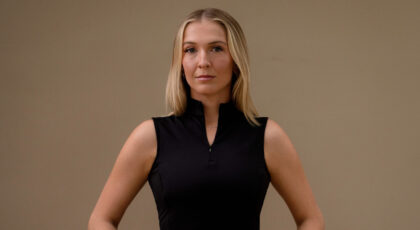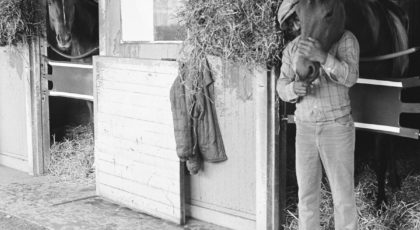Each week on #HallOfFameThursday, Horse Network recognizes members of the Show Jumping Hall of Fame with an inductee’s plaque, historical photos and, on the first Thursday of every month, an historic article about a Show Jumping Hall of Famer. As we begin Women’s History Month, we feature an article in the program of the 1989 American Invitational highlighting the accomplishments of women in show jumping. Doesn’t really seem like such an article would be necessary today!
Despite all of today’s talk about women’s liberation and equal rights, there is still one area in which men and women are almost always segregated, and probably always will be—the sports arena.
Of course, this makes good sense. After all, in what rough sport could a 110 pound woman possibly hope to compete successfully against male adversaries weighing 150 pounds or more?
The answer is show jumping, America’s fastest growing sport. Along with its related equestrian disciplines, dressage and three day eventing, show jumping is one of only three Olympic categories in which women are allowed to compete against men on an equal basis. All American Grandprix Association events are also open to both sexes.
At first glance, the contest hardly appears equal. Show jumpers are powerful, high-spirited animals, weighing well over half a ton. It takes strength to control them, and courage to attempt the huge obstacles of a grandprix course. While serious injuries are rare, there is a definite element of risk involved, which would seem to qualify this sport as “a man’s game.”
Nevertheless, women not only compete against men in show jumping, they beat them almost fifty percent of the time; which is not a bad average when you consider that male riders in a grandprix event usually outnumber the ladies by almost two to one.
In 1965, Mary Chapot won the first grandprix ever held in this country, setting a precedent that has kept the distaff side in the show jumping spotlight for more than two decades. Since the American Grandprix Association was formed in 1978, women have accounted for the AGA Rider Of The Year title four times, and last year 25-year-old Lisa Jacquin made a strong bid to become the fifth.
Jacquin, who somehow managed to balance show jumping competition with graduate school law studies, captured the lead early last season by winning both the Michelob Festival of Phoenix and the American Invitational, and held it until mid-August when she dropped to second place.
Riding For The Moment, Jacquin rallied to win the Cadillac Grandprix of Baltimore in October, but at the end of the season had to settle for third place behind Rodney Jenkins and Greg Best.
Although she battled and lost to two formidable male opponents Jacquin doesn’t believe that being a woman put her at any disadvantage
“To me, the main thing is the suitability of the rider to the horse,” she said. “It’s matching the right horse with the right rider to produce the best possible combination.”
“This is a sport that you really have to want to do,” she added. “It takes a lot of work and a lot of hours to get to the grandprix level, but I don’t think being a woman should necessarily be a drawback.”
Katie Monahan Prudent, one of the most successful riders—male or female—in show jumping history, agrees with Jacquin.
“I have never felt that I had an unfair disadvantage in competition, she said. “As for the lifestyle—riding traveling, competing—sometimes it’s hard, but I don’t think any more so for a woman. I think it suits me.”
Why are women able to challenge “male superiority” in this particular sport? “The horse is the equalizer,” Prudent explained. “Certainly women have to pick the horses they ride. But so do men. If you have good communication with your horse, in the long run that’s what matters.”
As the sport of show jumping has grown, women’s involvement has kept pace. In 1983, only six of the top thirty riders on the AGA circuit were female; today there are twice that number. Riders like Katie Prudent, Melanie Smith, and Leslie Lenehan have proven that this is one sport in which women actually compete against men as equals, and have inspired younger riders to take up the challenge. As Prudent phrases it. “The horse is the equalizer.”
Written by Marge Fernbacher, a freelance writer and former show jumping competitor.
The Show Jumping Hall of Fame is a 501(c)3 not-for-profit charity that relies solely on contributions to operate. If you liked this story, please consider supporting its efforts to preserve our sport’s history. Donations can be made online at www.ShowJumpingHallofFame.net.


 March 3, 2022
March 3, 2022 




























